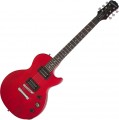Electric guitar pickup layout diagram. The letters used in this diagram indicate the types of pickups:
-
S - single. A single-coil pickup that looks like a narrow strip, often with a number of “buttons” (magnets) corresponding to the number of strings. Such modules provide clear and ringing sound, well suited for jazz, blues and other similar genres. On the other hand, the sound saturation from single-coils is not very high; they are poorly compatible with distortion and other similar effects, which is why they are poorly suited for “heavy” styles of music. In addition, such pickups are susceptible to external magnetic fields, which can degrade the sound.
-
H - humbucker. A type of pickup with two coils, originally created to compensate for the shortcomings of single coils - in particular, to reduce the level of interference from external magnetic interference. However, in the end it turned out that humbuckers differ noticeably in the color of the sound: it turns out to be less expressive, but more dense and rich, making it excellent for playing “overload” (distortion, overdrive, etc.). A classic pickup of this type has two coils positioned side by side, making it noticeably wider than a single coil; and Standard class humbuckers generally look like two single coils installed close to each other. However, in addition to this, there are other design options - for example, a hamcanseller
..., which has coils “on two levels” and is comparable in width to a single. Also note that there are humbuckers that can switch to single-coil mode (see “Coil Cutoff” for more details).
—J. A subtype of S-type pickups with one coil and an additional pole for each string. This variety first appeared on the legendary Fender Jazz Bass. J pickups have a versatile sound that suits almost any style of music.
—P. P pickups have two magnetized poles per string, but they have a unique feature: they are cut in half and wound in reverse. The advantage of this winding is the humbucker effect (see type “H”). The wide and long shape of the P pickup provides powerful and punchy sound in genres such as rock, metal, punk, etc.
- P90. A special type of single-spool single with a wider but shorter bobbin. These pickups are installed in the bridge or neck area of the guitar. Their distinctive feature is a characteristic “rock and roll” sound with warm, soft and rich timbres. Instruments with P90 pickups are often used in alternative rock, blues, indie, etc. styles.
The pickup diagram describes their types, number and relative positions. Our catalog uses a bridge-to-neck designation: for example, an HSS design means the guitar has one humbucker at the bridge and two single-coils near the neck.
This parameter determines, first of all, the overall color of the instrument’s sound. Thus, the above version of HSS will produce a sound that is quite clean and expressive, but at the same time a little denser and lower than on a purely “single-coil” electric guitar. There are many models available that are equipped with only one type of pickups. Moreover, the more pickups, the deeper and richer the sound, as a rule. In addition to all this, many other factors affect the sound of the instrument, so when choosing, you should not look only at the pickup circuit.The presence of a protective lining (pickguard) on the body of the guitar.
Such an overlay is located on the upper deck, most often made of durable plastic and differs markedly in colour, due to which it is clearly visible. Its main purpose is to protect the soundboard surface from pick strikes (for example, when playing with dynamic fighting), which could damage the varnished wooden surface. The specific shape and size of the fingerboard may vary, but anyway, it covers at least the surface below the strings (when looking at the guitar in the working position), and sometimes under the strings and even above them.

